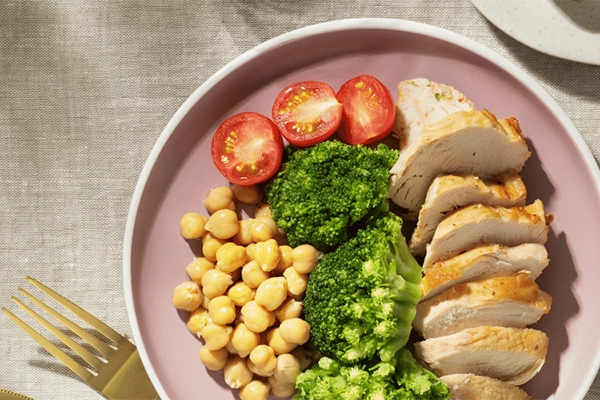Topics
What is the Healthy Eating Plate?
Healthy eating is about consuming food to fulfil our daily nutritional requirements while consciously avoiding factors that can contribute to diet-related diseases. Learn more about what healthy eating is (and is not).
Food and Meal Portion According to MOH
Malaysian healthy eating plate’s principle is known as ‘Quarter, Quarter, Half’ or ‘Suku, Suku, Separuh’. Based on this principle, if we practice healthy eating habits, we will be consuming the following portions for each meal:
- 1/4 plate of carbohydrates (wholegrain)
- 1/4 plate of protein
- 1/2 plate of fruits and vegetables
Let us understand this #quarterquarterhalf method in detail.
Fruits and Vegetables
Let’s start with the biggest portion on the plate: 1/2 plate of fruits and vegetables.
Fruits and vegetables are packed with nutrients such as antioxidants, vitamins and more. They are also considered ‘high-volume, low calorie’ food groups. In fact, vegetables are low in calories and can be a wonderful guilt-free snack. They are wonderful substitutes for sugar cravings too.
You can try asking your local mamak uncle to ‘add more vegetables’ into your rice or noodles the next time you have your meal at the mamak restaurant.
When it comes to fruits, whole fruits are better than fruit juices, as juicing strips away the dietary fibre. Fruit juices are absorbed faster and increase our blood sugar levels more rapidly. Find out how much fruit should we eat per day.
Fruits and vegetables also contain dietary fibre, otherwise known as roughage or bulk. Here are the health benefits on incorporating a fibre-rich diet in our daily balanced meals.
- Lowers cholesterol levels
High-fibre foods can help lower our total blood cholesterol levels by reducing the levels of low-density lipoprotein (LDL) - also known as ‘bad cholesterol’ and triglyceride. They also reduce blood pressure and inflammation in our body. - Stabilises blood sugar levels
High-fibre foods have been found to reduce the risk of type 2 diabetes mellitus. Fibre is indigestible by our body. Therefore, it does not cause a steep spike in plasma insulin, which is responsible for regulating our blood sugar levels. - Helps with weight loss
High-fibre foods keep you fuller for longer because they are not broken down in our body. Hence, they move slower through our digestive system. - Reduces risk of haemorrhoids
Haemorrhoids may occur due to excessive straining. Since a high-fibre diet prevents constipation, our stools pass more easily. Some studies show that a high-fibre diet also reduces the risk of getting colorectal (colon) cancer.
Carbohydrates
Let’s continue with the 1/4 plate of carbohydrates (whole grains).
Carbohydrates are an essential staple in our daily meals and nutritional needs. They provide us energy to carry out daily activities.
What matters the most is the type of carbohydrates that we consume. Therefore, we need to understand the difference between whole and refined carbohydrates.
Whole carbohydrates
Whole carbohydrates are complex carbs that contain more nutrients, minerals, and vitamins. Examples are whole grains, starchy vegetables, potatoes with skin, oats, quinoa, legumes, and wholemeal bread.
Refined carbohydrates
Refined carbohydrates are simple carbs (refined processed sugars) and refined complex carbs (refined grains) that have been heavily processed, and their natural fibres have been removed. Examples are white bread, white rice, and ultra-processed food products made from white flour and with added sugars.
Here’s what you can do to incorporate healthy, whole carbohydrates into your diet:
- Limit consumption of simple and refined carbs.
- Incorporate more complex carbs into every meal.
- Choose carbohydrates with a low Glycaemic Index (GI).
GI can be classified into 3 ratings:
- Low (≤55): Low GI foods have a lower glycaemic index and reduce blood sugar level spikes and cholesterol levels. Examples are fresh vegetables, fruits such as apple, watermelon, wholegrain bread, brown rice, oats.
- Moderate (56-69): Moderate GI foods are carbs-containing foods that are moderately absorbed after consumption. Examples are basmati rice, tosai, boiled potatoes, papaya.
- High (≥70): The higher the GI value, the faster the specific food that contains carbs raises blood glucose after consumption. Examples are fried foods, roti canai with dhal, glutinous rice, white rice, waffles.
Protein
Now let’s talk about the 1/4 plate of protein.
Protein is essential for building and maintaining muscle growth and regenerating new cells. Healthy sources of protein include fish, poultry, lean meat., eggs, nuts, beans, and legumes.
Here’s what you can do to incorporate healthy protein into your healthy diet:
- Avoid proteins that are deep-fried and highly processed because they are high in sodium, saturated fats, and trans-fats. Examples include processed, canned, and cured meat products.
- Reduce the consumption of red meat, as it can potentially increase cancer risk such as colorectal (colon) cancer.
- Choose steamed, grilled, and pan-fried protein instead.
- Tempeh and tofu (soybean products) are wonderful vegetarian alternatives for protein.
Make an appointment at Pantai Hospitals
A nutritious and balanced diet is crucial for us to stay happy and healthy. Apart from having adequate nutrition, do remember to stay hydrated by drinking plenty of water, reduce your refined sugar intake, especially ultra-processed food products that are high in added sugar, refined carbs, and trans-fats.
It is possible to enjoy our diverse Malaysian cuisines while pursuing health. We just need to be mindful, practice moderation, and be intentional in choosing healthier alternatives!
If you have questions about how to practice healthy eating and having adequate nutrition in your daily diet, contact the team of dietitians at your nearest Pantai Hospital to receive professional dietary advice to help kickstart your health journey.
To make an appointment for health screening, please contact the health screening centre at the Pantai Hospital nearest to you.
Pantai Hospitals have been accredited by the Malaysian Society for Quality in Health (MSQH) for its commitment to patient safety and service quality.
References
- Intervensi Pengurusan Berat Badan, Kementerian Kesihatan Malaysia. Available at https://www.infosihat.gov.my/images/media_sihat/garis_panduan/pdf/Modul_4-Pelan_Pemakanan_NEW.pdf [Accessed on 30 August 2022]
- Malaysian Dietary Guidelines 2020. Available at https://nutrition.moh.gov.my/wp-content/uploads/2021/07/Web%20MDG.pdf [Accessed on 30 August 2022]
- Glycaemic Index & Glycaemic Load. Available at http://pendidikanpesakit.myhealth.gov.my/en/glycaemic-index-and-glycaemic-load/ [Accessed on 30 August 2022]
- Effects of dietary fibre and carbohydrate on glucose and lipoprotein metabolism in diabetic patients. Available at https://diabetesjournals.org/care/article/14/12/1115/16477/Effects-of-Dietary-Fiber-and-Carbohydrate-on [Accessed on 30 August 2022]
- Eating fruit is better for you than drinking fruit juice. Available at https://www.health.harvard.edu/staying-healthy/news-briefs-eating-fruit-is-better-for-you-than-drinking-fruit-juice [Accessed on 30 August 2022]
- Red meat, processed meat and cancer. Available at https://www.cancercouncil.com.au/1in3cancers/lifestyle-choices-and-cancer/red-meat-processed-meat-and-cancer/#:~:text=Consuming%20too%20much%20red%20and,18%25%20of%20bowel%20cancer%20cases.&text=Processed%20meat%20is%20classified%20as,cause%20them%20to%20be%20carcinogenic [Accessed on 30 August 2022]
- Animal vs. Plant Protein — What’s the Difference? Available at https://www.healthline.com/nutrition/animal-vs-plant-protein [Accessed on 30 August 2022]













